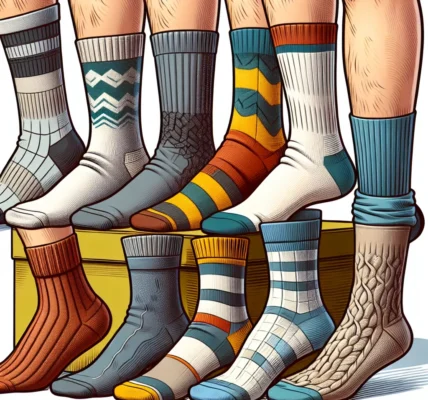Improved Circulation and Reduced Swelling
Compression socks are not only fashionable but also offer a range of health benefits, including improved circulation and reduced swelling. These specialized socks are designed to apply pressure to your lower legs, helping to maintain blood flow and reduce discomfort and swelling. By gently squeezing the legs, compression socks help the veins and muscles move blood more efficiently, preventing it from pooling in the lower extremities. This improved circulation can alleviate symptoms of conditions such as varicose veins and edema, as well as prevent blood clots from forming.
Furthermore, wearing compression socks can be particularly beneficial for individuals who spend prolonged periods sitting or standing, such as office workers, travelers, or athletes. The consistent pressure applied by the socks can aid in preventing the onset of swelling and fatigue that often accompanies prolonged immobility. Research suggests that wearing compression socks during long flights or extended periods of sitting can significantly reduce the risk of developing deep vein thrombosis (DVT) and the discomfort associated with swollen legs and ankles.
In addition to these specific health benefits, improved circulation and reduced swelling resulting from wearing compression socks can contribute to overall comfort and well-being. Whether you’re looking to enhance your athletic performance, alleviate leg pain, or simply improve your day-to-day comfort, the surprising health benefits of compression socks make them a valuable addition to anyone’s wardrobe.
Enhanced Athletic Performance and Recovery
Compression socks have gained popularity not only for their medical benefits but also for their potential to enhance athletic performance and recovery. Athletes, both professional and amateur, have increasingly turned to compression socks to improve their overall performance and speed up their recovery process. Research suggests that wearing compression socks during physical activity can lead to improved blood flow, increased oxygen delivery to muscles, and better removal of metabolic byproducts, ultimately resulting in enhanced athletic performance.
One of the key benefits of compression socks for athletes is their ability to reduce muscle soreness and fatigue. The graduated pressure applied by the socks can help minimize muscle vibration during exercise, which in turn can lower the risk of micro-tears and delayed onset muscle soreness (DOMS). This means that athletes may experience less pain and discomfort post-workout, allowing for quicker recovery and potentially enabling them to train more consistently and at a higher intensity.
Furthermore, wearing compression socks during and after exercise has been shown to aid in the rapid removal of lactic acid from muscles. This is crucial for athletes as the build-up of lactic acid is often associated with muscle fatigue and decreased performance. By promoting efficient circulation and oxygenation, compression socks can help athletes push their limits and recover faster between training sessions.
In conclusion, the use of compression socks can play a valuable role in enhancing athletic performance and expediting recovery. Athletes looking to optimize their training and improve their overall physical condition can benefit from incorporating compression socks into their workout routines.
Lowered Risk of Deep Vein Thrombosis
Wearing compression socks has been shown to offer a wide range of health benefits, and one surprising advantage is the lowered risk of deep vein thrombosis (DVT). DVT occurs when a blood clot forms in a deep vein, usually in the legs, and can lead to serious complications if left untreated. Compression socks work by applying pressure to the legs, which helps to improve blood circulation and prevent blood from pooling in the veins. This gentle pressure also reduces the diameter of the veins, which in turn increases the velocity of blood flow.
Studies have suggested that wearing compression socks, especially during long periods of inactivity such as long flights or extended periods of sitting, can significantly lower the risk of developing DVT. This is particularly important for individuals who may be at higher risk of this condition, such as frequent travelers, pregnant women, or those with a family history of blood clots.
By improving blood flow and circulation, compression socks can effectively reduce the likelihood of blood clot formation, ultimately decreasing the risk of DVT. This simple yet effective measure can be easily incorporated into daily life, offering a proactive approach to maintaining vascular health and reducing the potential for serious complications associated with DVT.
Management of Varicose Veins
Compression socks are not only known for providing relief to tired and achy legs, but they also play a crucial role in the management of varicose veins. Varicose veins occur when the valves in the veins weaken, causing blood to pool in the legs, and resulting in enlarged and twisted veins. Wearing compression socks can effectively aid in the management of varicose veins by applying gentle pressure to the legs, which helps improve circulation and reduce the swelling and discomfort associated with this condition.
The graduated pressure exerted by compression socks promotes the upward flow of blood towards the heart, preventing it from pooling in the lower extremities. This can alleviate the symptoms of varicose veins such as pain, heaviness, and fatigue in the legs. Additionally, compression socks can help prevent the progression of varicose veins and reduce the risk of developing complications such as leg ulcers and blood clots.
Furthermore, wearing compression socks during prolonged periods of sitting or standing can significantly decrease the likelihood of developing varicose veins. The consistent pressure applied by compression socks supports the vein walls and helps maintain proper circulation, thus reducing the strain on the veins and lowering the risk of varicose veins formation.
In conclusion, the utilization of compression socks is an effective and non-invasive way to manage and prevent varicose veins. By improving blood circulation and providing support to the veins, compression socks offer a valuable solution for individuals seeking relief from the discomfort of varicose veins and aiming to maintain optimal leg health.




